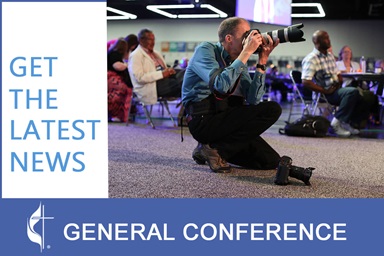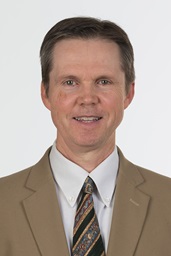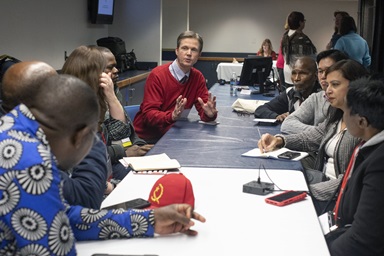Eight years ago, when it seemed inevitable that Christ United Methodist Church in San Diego would eventually close, the Rev. Bill Jenkins convinced his dwindling congregation to take a slightly different path.
In the process, the congregation offered a home to a dozen multi-ethnic congregations of various faiths and space to social programs serving their North Park neighborhood while saving a historic building.
Sharing information
The success of Christ Church Ministry Center led the Rev. Bill Jenkins to the realization that while many San Diego organizations offer assistance to the poor, information about those services was not readily available.
He used his technology experience to create a central online directory, The Fount of Blessings, using metaphors from the hymn, “Come Thou Fount,” to detail the hundreds of resources available in San Diego from churches, charities and social agencies. A short video at MyFount.com explains how it works.
“The Fount has the potential to revolutionize the way organizations can more easily and effectively work together to direct those in need to almost any resource available in their area,” Jenkins explained.
When it was constructed in the 1950s, what was then the First Evangelical United Brethren Church of San Diego housed the largest EUB congregation west of the Rocky Mountains. The Evangelical United Brethren and Methodist denominations merged to form the United Methodist Church in 1968.
As with many urban churches, times had changed at Christ church. “Here was a church that was used one hour on a Sunday morning,” explained Jenkins, who became pastor there in 1999. “Some of those rooms had not been used in decades.”
Today, the doors at the 25,000-square-foot Christ United Methodist Ministry Center open at 8 a.m. daily and don’t close again until 9:30 or 10 p.m., touching some 1,000 lives a week, he estimated. “It was just amazing the people God brought to us,” the 66-year-old pastor said.
The transformation came with the support of the United Methodist California-Pacific Annual (regional) Conference. “Like a lot of urban congregations, its core members were mostly commuting from other places,” recalled the Rev. Myron Wingfield, who was the South District superintendent at the time and now is on staff at the United Methodist Board of Higher Education and Ministry in Nashville, Tennessee.
What made the project work were good collaborative choices, Wingfield added. Church members were willing to start meeting the needs of the community, with Jenkins providing the leadership.
“It’s an uncommon collection of factors that really has led to a vital presence of ministry in that location,” he added.
Trajectory toward social justice
Perhaps the most important factor is Jenkins himself, who stayed on the center’s executive director. Like the church, he has been on a lifelong journey of transformation and faith.
As a teenager living in segregated Yazoo City, Mississippi, in the 1960s, Jenkins found his white friends were more interested in the 100th anniversary of the Civil War than the passage of the Civil Rights Act.
But he had a different perspective, he said, gained from the summers he spent helping his father with a dry cleaning route in the Delta, where 90 percent of the clients were black sharecroppers. As a Delta State University student, he broke the color barrier at an all-black high school when he took a student teaching position there.
The two experiences, Jenkins explained, “set my life in a whole different trajectory.”
Advice for ministry center model
The Rev. Bill Jenkins offers some advice for those contemplating the ministry center model:
Don’t Just Survive. Keeping the doors open is not an indication of vital ministry. Many dying urban churches find ways to prolong their existence while avoiding facing the reality of failure to connect with their changing neighborhood and culture.
It’s God’s church. We all form emotional attachments to our home church, but the building, traditions or rituals are never a substitute for genuine ministry.
Relinquish Control. Declining urban churches need to trust other groups to do what they do best without trying to control them.
Use the “Matthew 25 Model.” Have as many ministries focused around hunger, thirst (including spiritual thirst), clothing, wellness, prison and befriending strangers as possible.
Get Down and Dirty. There is no sanitized way of doing urban ministry or any ministry, for that matter. Expect that often those in greatest need may appear the least lovable.
Think Abundance, not Scarcity. Jesus took a few loaves and fishes to feed five thousand (just counting the men). There is an abundance of help out there being provided by churches, charities and social agencies but it needs to be coordinated.
Trust God. Urban ministries will always struggle to survive, much like those we are called to help. Revenues will come and go. Charities and congregations will, too. Anxiety is the opposite of faith.
His life in the ministry began with ordination in the Southern Baptist Church at the age of 20. The ideological shift in the Southern Baptist Convention after 1978 was troubling to Jenkins and when he joined The United Methodist Church in 1988, “I knew that I was home,” he recalled.
Wingfield credits the “tri-vocational” experience that Jenkins gained over the years — in education and technology as well as the ministry — “combined with a very passionate faith and guided by a generous willingness to truly be the church” with making the project sustainable.
“The diversity of the community brought together there is also a key piece,” Wingfield said, adding that Jenkins’ willingness to open the space to congregations of other denominations and develop a relationship with their leaders and key members was in “the Catholic spirit” espoused by John Wesley, the founder of Methodism.
Fostering diversity
A prime example is the Haitian gospel music group, “Louange a Dieu” – Creole for "Praises to God.” Jenkins befriended the group in 2009 after he learned gangs in Haiti were persecuting them.
Jenkins made the chapel available to the group on Sunday evenings, but the help didn’t stop there. “We converted space in the church so they could live, sleep, cook and shower in the huge building,” he explained. Then he searched for “the best immigration attorney I could find.”
After a massive earthquake struck Haiti on Jan. 12, 2010, the now-established Haitian Methodist congregation became “the hub” of relief efforts in San Diego, Jenkins said.
When Haitians refugees began to reach the U.S. border through Mexico, U.S. Immigration and Custom Enforcement officers turned to the congregation and Christ Church for help and translation services. With assistance from the United Methodist Committee on Relief and Catholic Charities of San Diego, former Sunday school rooms in the education building were transformed into temporary housing for more than 300 Haitian refugees.
The granting of temporary protected status to Haitians who were in the United States before the earthquake “was a game changer for them,” Jenkins said about the Haitian congregation. “They were able to get jobs, such as orderlies and custodians at the hospital and nursing homes. Most enrolled in extension courses to pick up marketable skills.”
Jenkins said he is humbled and proud to be called “father” by the Haitian group. “I consider the Haitians my children, especially the original Louange a Dieu group,” he explained. “They are young adults, and we have been through so much together.”
Death leads to resurrection
Realizing that the original Christ United Methodist Church was no longer sustainable in a traditional sense, the South District, which includes San Diego, and then Bishop Mary Ann Swenson were willing “to name that and embrace a certain type of death with hope of resurrection,” Wingfield said.
The church was de-commissioned in 2011 — although Christ Chapel, a small United Methodist group, still worships there — and the ministry center emerged. As a retired elder, Jenkins could still serve the sacraments and provide denominational oversight.
Admittedly, for a period of time after the transition, Christ Ministry Center “kind of fell off the radar” for the conference, said the Rev. John Farley, Wingfield’s successor as district superintendent. “Bill was there just keeping things going without any official capacity.”
Farley said he admires the way Jenkins has claimed the history of change, renewal and rebirth in an older neighborhood that is ethnically diverse and becoming popular with young families.
“Bill’s kind of an entrepreneurial spirit and a great evangelical spirit at the same time,” he said.
What’s most exciting to Farley is the connection that is growing among four of the faith groups meeting at the ministry center who together average 220 in worship. “The story we say is they fell in love with each other,” he explained. “They began to feel like a unique family. Organically, this diversity began to sort of merge.”
The groups have been studying Methodist theology and are considering a constituting conference to become a new United Methodist congregation. “They’re finding a home in Wesleyan grace,” Farley said.
*Bloom is a United Methodist News Service multimedia reporter based in New York. Follow her at http://twitter.com/umcscribe or contact her at (646) 369-3759 or [email protected].
Like what you're reading? Support the ministry of UM News! Your support ensures the latest denominational news, dynamic stories and informative articles will continue to connect our global community. Make a tax-deductible donation at ResourceUMC.org/GiveUMCom.




